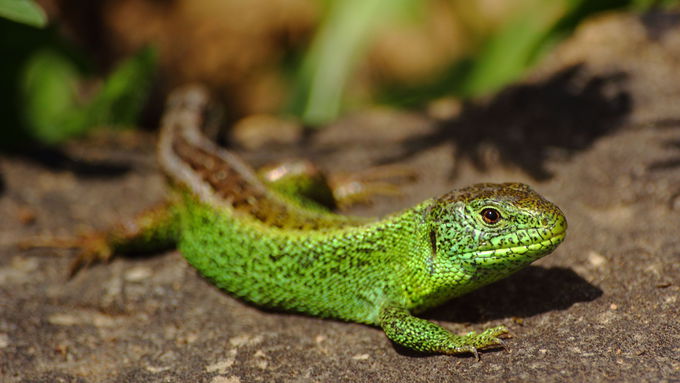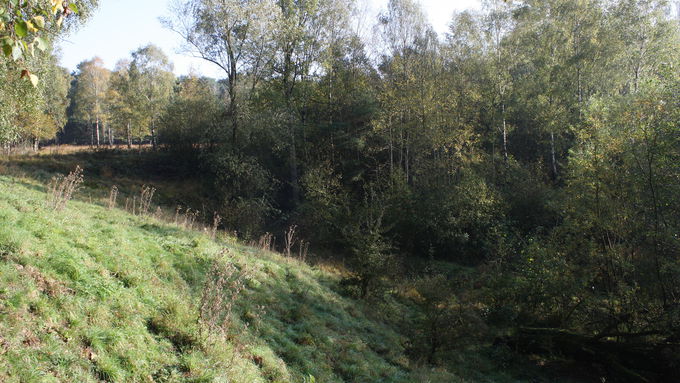The action in the nature reserve ‘Lichtenhagen’ shall benefit the sand lizard, among others. © Christoph Caina / Wikimedia Commons / CC BY 3.0 (https://commons.wikimedia.org/wiki/File:Lacerta_agilis_male_2.JPG), „Lacerta agilis male 2“, https://creativecommons.org/licenses/by-sa/3.0/legalcode
download picturemain content
Project of the month
#07/2020 DEVELOPMENT OF WET HEATHS AND OPTIMIZATION OF HABITATS FOR REPTILES
Additional habitat for the sand lizard in the SAC ‘Lichtenhagen’
The nature reserve ‘Lichtenhagen’ comprises a former excavation area west of Schermbeck at the Lower Rhine and is located in the local subdistricts Bricht and Overbeck. Clay was mined here until the 1970s. The area of about 110 hectares was designated as a nature reserve in 1981. It is of state-wide importance due to the completeness of the characteristic habitats to be found, such as wet heaths, semi-natural standing waterbodies, meandering streams, old acidophilous oak forests, alder-ash forests and low moor areas. The area is particularly important as a habitat for numerous endangered amphibian and reptile species, such as sand lizard (Lacerta agilis), moor frog (Rana arvalis), crested newt (Triturus cristatus) and fire salamander (Salamandra salamandra). Some rare bird species also occur in the nature reserve: The black woodpecker (Dryocopus martius) breeds in the area and kingfisher (Alcedo atthis), woodcock (Scolopax rusticola), honey buzzard (Pernis apivorus) and reed warbler (Acrocephalus scirpaceus) have significant occurrences. In 1999, about 99 hectares of the nature reserve were therefore also designated as the Special Area of Conservation ‘Lichtenhagen’ (DE-4207-301).
Within the framework of the LIFE IP Atlantic Region DE, various measures to develop wet heaths and optimize habitats for reptiles were carried out in cooperation with the Regionalverband Ruhr (RVR Ruhr Grün), the Biological Station in the district of Wesel and the Lower Nature Conservation Authority in the district of Wesel in October and November 2019. The worked area was divided into several sub-areas with different habitat types.
For one part of the area, the focus was on optimizing the habitats for the sand lizard. For this purpose, the bushes of birch, poplar and alder which had grown by succession were removed. In order to preserve and develop the poor grassland, the areas were newly fenced in so that they can be managed extensively by sheep grazing in the future. The sun-exposed slopes were enriched with suitable structural elements.
Another area had shown degenerated wet heaths of the habitat type 4010 before the start of the action. This site was newly created and thus connected to an existing occurrence of this habitat type. For this purpose, shoots and shrubbery in the area were eradicated; afterwards, the humic topsoil was removed and spread as a flat rampart on adjacent areas.
Related Topics
Further Links
- SAC ‘Lichtenhagen’ (DE-4207-301) – Landesamt für Natur, Umwelt und Verbraucherschutz Nordrhein-Westfalen (in German) (external link opens in a new window)
- Nature reserve ‘Lichtenhagen’ (WES-009) – Landesamt für Natur, Umwelt und Verbraucherschutz Nordrhein-Westfalen (in German) (external link opens in a new window)
- Regionalverband Ruhr (in German) (external link opens in a new window)
- Biological Station in the district of Wesel (in German) (external link opens in a new window)
- Lower Nature Conservation Authority in the district of Wesel (external link opens in a new window)





